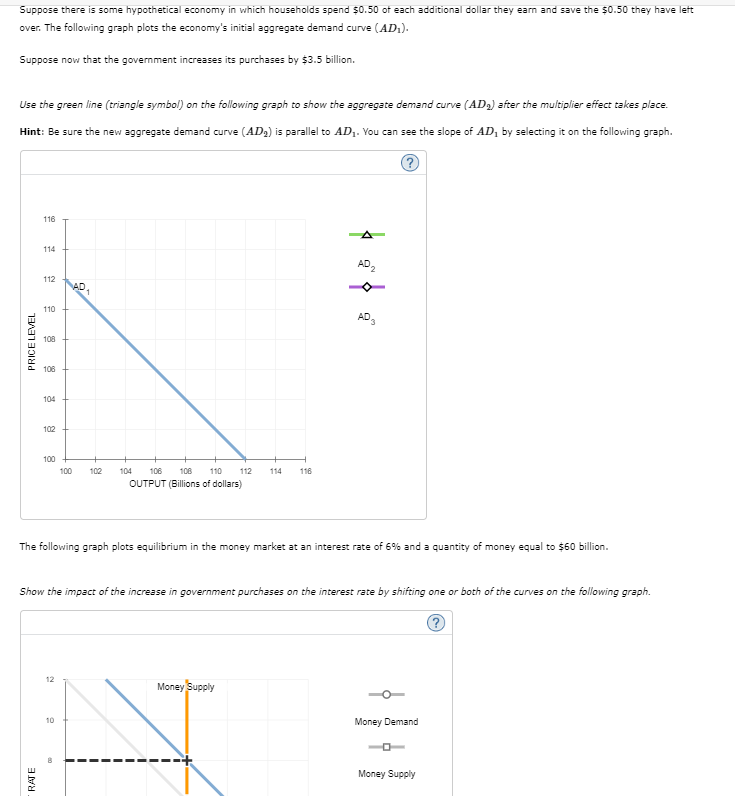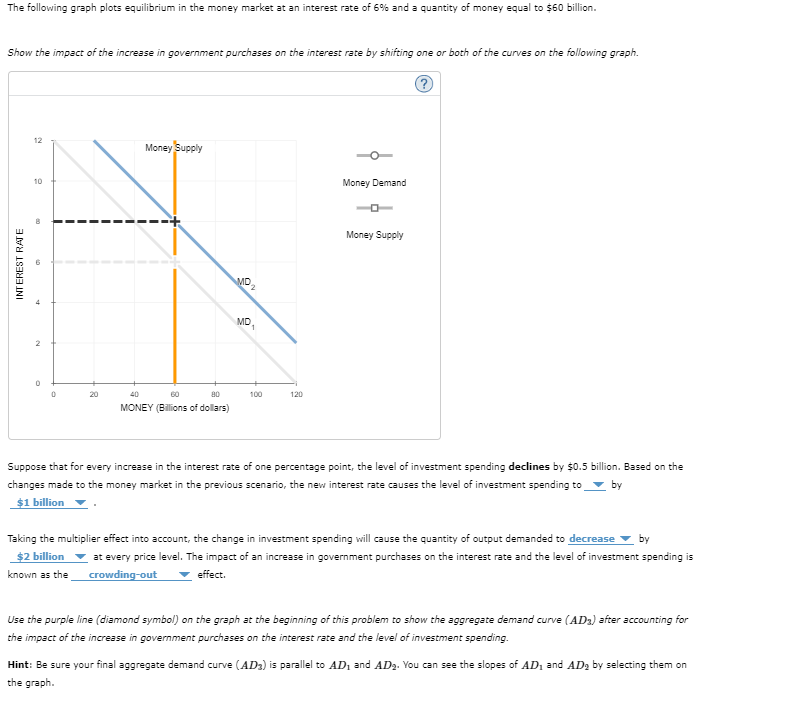Suppose there is some hypothetical economy in which households spend $0.50 of each additional dollar they earn and save the $0.50 they have left over. The following graph plots the economy's initial aggregate demand curve (AD₂). Suppose now that the government increases its purchases by $3.5 billion. Use the green line (triangle symbol) on the following graph to show the aggregate demand curve (AD₂) after the multiplier effect takes place. Hint: Be sure the new aggregate demand curve (AD₂) is parallel to AD₁. You can see the slope of AD, by selecting it on the following graph. PRICE LEVEL 116 114 112 110 108 106 104 102 100 100 102 104 106 108 110 OUTPUT (Billions of dollars) 112 114 116 4 4 2 AD₂
Suppose there is some hypothetical economy in which households spend $0.50 of each additional dollar they earn and save the $0.50 they have left over. The following graph plots the economy's initial aggregate demand curve (AD₂). Suppose now that the government increases its purchases by $3.5 billion. Use the green line (triangle symbol) on the following graph to show the aggregate demand curve (AD₂) after the multiplier effect takes place. Hint: Be sure the new aggregate demand curve (AD₂) is parallel to AD₁. You can see the slope of AD, by selecting it on the following graph. PRICE LEVEL 116 114 112 110 108 106 104 102 100 100 102 104 106 108 110 OUTPUT (Billions of dollars) 112 114 116 4 4 2 AD₂
Chapter9: Demand-side Equilibrium: Unemployment Or Inflation?
Section9.A: The Simple Algebra Of Income Determination And The Multiplier
Problem 4TY
Related questions
Question

Transcribed Image Text:Suppose there is some hypothetical economy in which households spend $0.50 of each additional dollar they earn and save the $0.50 they have left
over. The following graph plots the economy's initial aggregate demand curve (AD₂).
Suppose now that the government increases its purchases by $3.5 billion.
Use the green line (triangle symbol) on the following graph to show the aggregate demand curve (AD₂) after the multiplier effect takes place.
Hint: Be sure the new aggregate demand curve (AD₂) is parallel to AD₁. You can see the slope of AD₁ by selecting it on the following graph.
?
PRICE LEVEL
116
114
RATE
112
110
108
106
104
102
100
12
100
10
AD,
09
102
104 106 108 110 112
OUTPUT (Billions of dollars)
The following graph plots equilibrium in the money market at an interest rate of 6% and a quantity of money equal to $60 billion.
114 116
Show the impact of the increase in government purchases on the interest rate by shifting one or both of the curves on the following graph.
?
þ 4
Money Supply
AD₂
AD₂
Money Demand
Money Supply

Transcribed Image Text:The following graph plots equilibrium in the money market at an interest rate of 6% and a quantity of money equal to $60 billion.
Show the impact of the increase in government purchases on the interest rate by shifting one or both of the curves on the following graph.
INTEREST RATE
12
10
2
0
20
Money Supply
40
60
80
MONEY (Billions of dollars)
MD2
MD,
100
120
Money Demand
Money Supply
Suppose that for every increase in the interest rate of one percentage point, the level of investment spending declines by $0.5 billion. Based on the
changes made to the money market in the previous scenario, the new interest rate causes the level of investment spending to by
$1 billion
Taking the multiplier effect into account, the change in investment spending will cause the quantity of output demanded to decrease by
$2 billion at every price level. The impact of an increase in government purchases on the interest rate and the level of investment spending is
crowding-out effect.
known as the
Use the purple line (diamond symbol) on the graph at the beginning of this problem to show the aggregate demand curve (AD3) after accounting for
the impact of the increase in government purchases on the interest rate and the level of investment spending.
Hint: Be sure your final aggregate demand curve (AD3) is parallel to AD, and AD₂. You can see the slopes of AD₁ and AD₂ by selecting them on
the graph.
Expert Solution
This question has been solved!
Explore an expertly crafted, step-by-step solution for a thorough understanding of key concepts.
This is a popular solution!
Trending now
This is a popular solution!
Step by step
Solved in 5 steps with 3 images

Follow-up Questions
Read through expert solutions to related follow-up questions below.
Follow-up Question
How am I supposed to plot a figure thats not even on the graph and What are the answers to the questions that were not answered. These questions:
Suppose that for every increase in the interest rate of one percentage point, the level of investment spending declines by $0.5 billion. Based on the changes made to the money market in the previous scenario, the new interest rate causes the level of investment spending to by .
Taking the multiplier effect into account, the change in investment spending will cause the quantity of output demanded to by at every price level. The impact of an increase in government purchases on the interest rate and the level of investment spending is known as the effect.
Use the purple line (diamond symbol) on the graph at the beginning of this problem to show the aggregate demand curve (AD3AD3) after accounting for the impact of the increase in government purchases on the interest rate and the level of investment spending.
Hint: Be sure your final aggregate demand curve (AD3AD3) is parallel to AD1AD1 and AD2AD2. You can see the slopes of AD1AD1 and AD2AD2 by selecting them on the graph.
Solution
Knowledge Booster
Learn more about
Need a deep-dive on the concept behind this application? Look no further. Learn more about this topic, economics and related others by exploring similar questions and additional content below.Recommended textbooks for you








Macroeconomics: Principles and Policy (MindTap Co…
Economics
ISBN:
9781305280601
Author:
William J. Baumol, Alan S. Blinder
Publisher:
Cengage Learning
